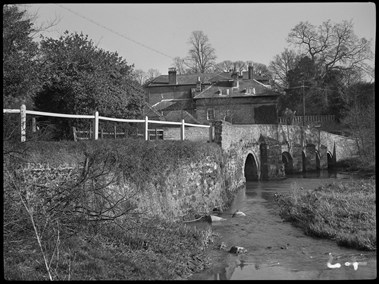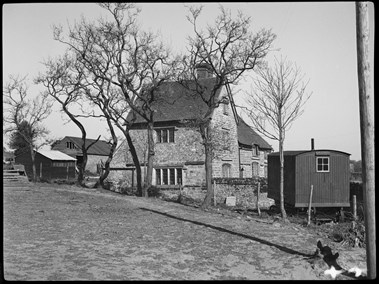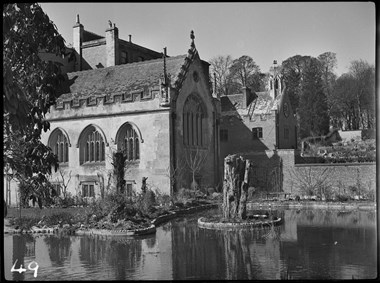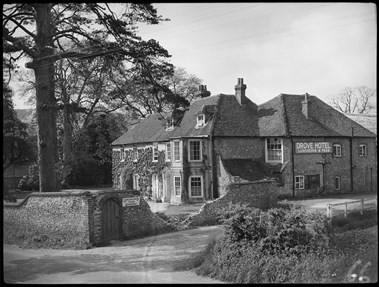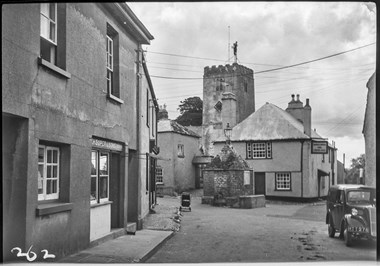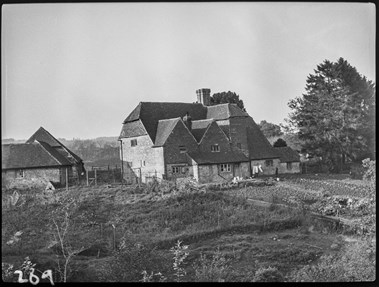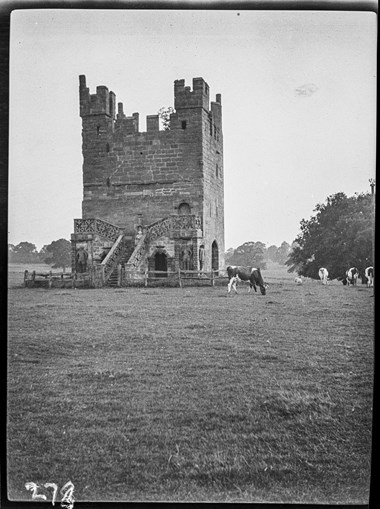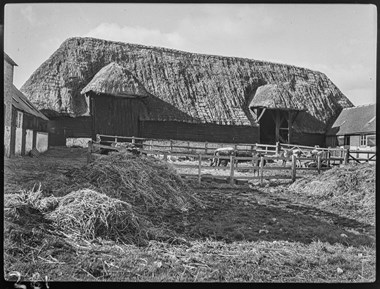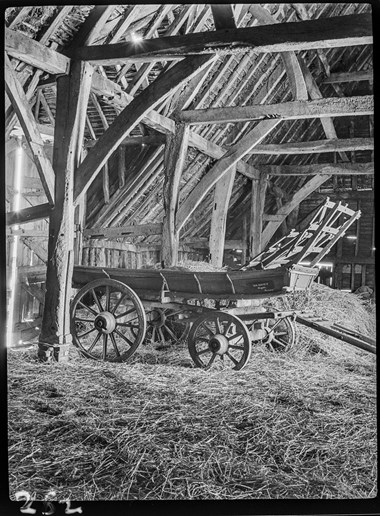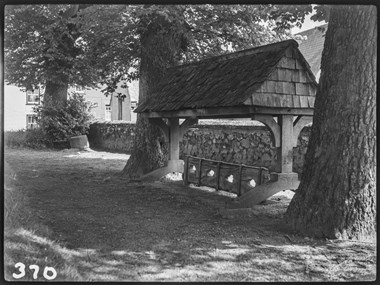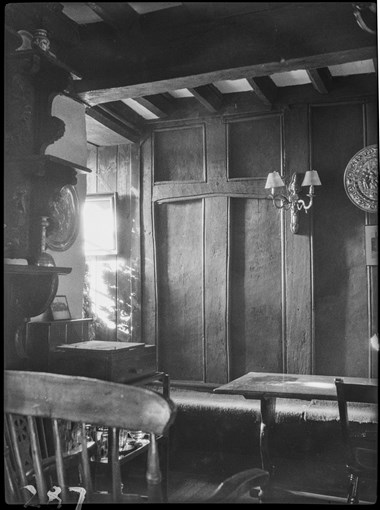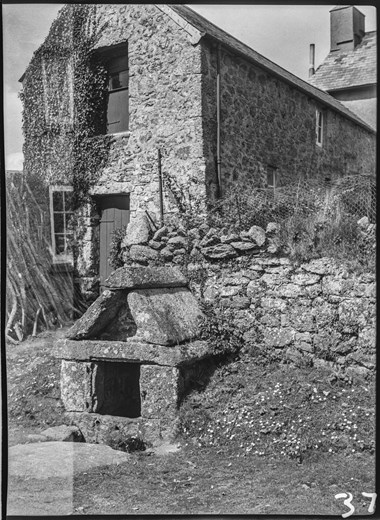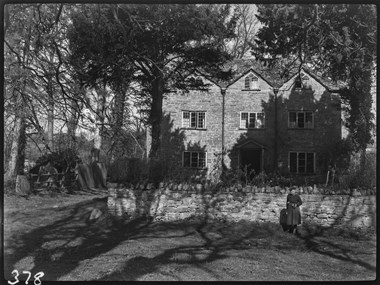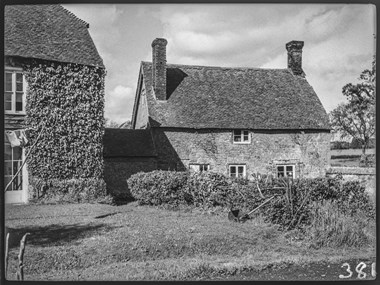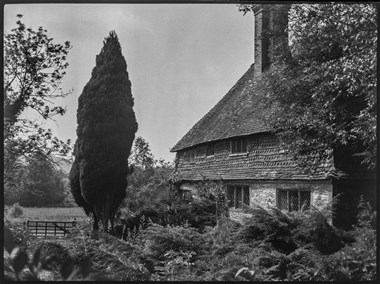Emilie Montgomery Gardner (1882-1959)
American-born Emilie Montgomery Gardner was a committed campaigner for women’s suffrage who later worked for the Ministry of Housing and Local Government. Our collection of 1,800 of her photographs records cottages, farmhouses and bridges in early post-war southern England, many of which would later be listed for their architectural and historical interest.
Who was Emilie Montgomery Gardner?
Emilie Montgomery Gardner led a remarkable life. She was a committed campaigner for women’s suffrage, a teacher, a wartime Red Cross nurse, civil servant and heritage activist.
Emilie Montgomery Gardner was born on 30 September 1882 in New Haven, Connecticut, United States of America. Her parents moved to England in 1892 – her father came to establish a company to manufacture steel and iron chains. The intention was for the family to return home once the new company was established but they stayed in England and Emilie became a naturalised British citizen in 1912.
Gardner attended a boarding school in Edgbaston, Birmingham and won a scholarship to Newnham College, Cambridge. Her younger sister Elinor also studied at Newnham and became a pioneering geoscientist.
Prior to the First World War, Gardner was active in the National Union of Women’s Suffrage Societies. She also worked as a secondary school teacher in London. During the war she became a Red Cross nurse, living in Wells, Somerset. After the war, she joined the Civil Service and became a District Officer in the Assistance Board. In 1942 she was awarded OBE in the King’s Birthday Honours for her services to the Civil Service.
Emilie Montgomery Gardner, suffragist
Whilst in her 20s and 30s, Emilie Montgomery Gardner was a committed suffragist, actively campaigning for the cause of votes for women.
In 1908 she took part in national Union of Women’s Suffrage Societies tours to promote the suffrage cause. On 2 July 1908, Gardner and a group of friends from Newnham College began a tour in Beattock, Dumfries and Galloway. They hired a horse-drawn caravan, named ‘Eva’, which was pulled by Jock the horse and driven by Charles, ‘a silent Scotchman’. They decorated it with posters and used it as a platform to host meetings. Whilst some of the group travelled by caravan, others rode on bicycles, scouting ahead for overnight camping places.
We ask for no favour, we simply ask that we be allowed to start fairly in this race for life.
The tour headed south through Lockerbie, Longtown, Carlisle, Workington, Cockermouth, Keswick, Ambleside, Windermere, Kendal and Kirkby Lonsdale. It was planned that two open-air meetings would be held each day around midday and in the evening.
The tour concluded in Oxford on 29 July where a well-attended meeting, presided by Mrs Alys Russell, social relief organiser and wife of Bertrand Russell, was held in St Giles’ in front of a crowd of 2-300 men and women.
A caravan tour of Yorkshire followed in August 1908, which again involved open-air public meetings. The tour included seaside towns, such as Whitby and Bridlington, where audiences would include locals and holidaymakers.
Soon after, Gardner became the Secretary of the Birmingham and Midland Women’s Suffrage Society. She campaigned for a reorganisation of the local branches of the NUWSS to create a more cohesive and stronger organisation.
Emilie Montgomery Gardner and the National Buildings Record
The National Buildings Record (NBR) was established in 1941 to record historic buildings threatened with destruction from aerial bombing. It continued to operate after the Second World War, collecting and commissioning photographs of the nation’s heritage. Gardner considered the NBR to be a ‘splendid thing’ and began supplying photographs to the organisation after the war.
In 1948, Gardner moved to lodgings in Devon to begin work as a temporary investigator with the Ministry of Housing and Local Government in Devon and Dorset. She made recommendations for the listing of buildings of special architectural or historical interest.
Shortly before starting her job, Gardner contacted Walter Godfrey, Director of the NBR, offering to take photographs of buildings for the Record and sending some examples of her work. Gardner was keen to mention that she would be covering ‘ground that is outside Mrs Tomlinson’s beat’ – Mrs Tomlinson being Margaret Tomlinson, who had been engaged by the NBR to photograph buildings in the south west of England during the Second World War.
Around this time, it wasn’t easy to obtain camera film but the NBR was able to supply Gardner with 120 roll film supplied by Ilford for her German-made Zeiss camera. She used this camera exclusively until she acquired the use of a Rolleiflex in early 1957.
The arrangement was for Gardner to take the photographs, process the film and send the negatives to the NBR. In return, she would receive a set of photographs printed by the NBR. Later, Gardner took responsibility for purchasing the films and billed the NBR for reimbursement. On 12 March 1948, Gardner sent her first batch of 16 negatives to the NBR.
I wish that you would tell me if I am taking things that you do not consider worth having, or if the angle or the distance from which the building is taken makes it of little value. With my small camera, I am often restricted in the view I can take, but it is extravagant to waste a film if it is not going to be of use to you.
Many thanks for the further set of negatives. I have looked through them carefully, and they are as before just the kind of think [sic] we want, and we are very glad to have your help in this way.
Despite some concerns about the quality of the photographs she was taking for the NBR, particularly regarding lighting and composition, and the value of the buildings she was recording, Cecil Farthing, the NBR’s Deputy Director assured her that her photographs were ‘just the kind of think [sic] we want, and we are very glad to have your help in this way.’
By the middle of July 1948, Gardner had sent the NBR 11 sets of negatives and was encouraged to extend her coverage into Dorset, especially to photograph small houses and cottages, which would help fill gaps in the NBR’s collection.
As well as taking photographs of sites in Devon, Gardner also offered to take photographs of rural buildings in West Sussex during trips back to her home in Borden Village, and of places she would encounter on her journeys through the counties between them. She also offered to photograph buildings whilst on trips elsewhere, including in Staffordshire, Shropshire and Herefordshire. During a trip to the Isle of Man in 1958, she arranged for copies of photographs from the Manx Museum to be sent to the NBR.
In July 1956, Gardner reached the milestone of sending her 100th set of negatives to the NBR. Around this time, there was some concern regarding the use of some of her photographs. From the start of her arrangement with the NBR, Gardner retained copyright of her work. In the summer of 1956, she discovered that a ‘distinguished editor’ had reproduced some images sourced from the NBR without her permission. Gardner revealed that the culprit was her friend, Louis Francis Salzman, editor of the Victoria County History. A concerned Cecil Farthing wrote to confirm that steps would be taken to ensure it was not repeated.
Emilie Montgomery Gardner’s own interests also included watermills. She was instrumental in the addition of watermills to the Windmill Section of the Society for the Protection of Ancient Buildings (SPAB), which became the Wind and Watermill Section in 1946. She served on the Section’s committee from 1951 to 1959.
In October 1949, Gardner suggested that her own mill photographs would make a good collection for the NBR, which it soon began to copy and add to its records. The NBR made prints from the negatives and returned the negatives to Gardner.
The SPAB Mills Section still operates and its EM Gardner Collection of over 2,000 images and documents was transferred to the Mills Archive in 2004.
In addition to mills, Gardner also had an interest in churchyard memorial stones. This led to further contact with the NBR. She was involved in the formation of a sub-committee of the West Sussex Archaeological Society that was dedicated to their survey. In early 1957, Gardner approached Cecil Farthing for support in the recording of carvings before they were lost to weathering. Farthing was happy for Gardner to include photographs of tombstones in the course of her NBR recording.
Later that summer, Gardner approached Farthing again about support for others involved in photographing memorial stones. Unfortunately, financial pressures meant that the NBR had to cut back on non-essential expenditure and couldn’t offer any expenses for films and prints for a discreet tombstone survey.
Dear Mr Farthing, The last year was not photogenic and I have done little. Any hope of help with the tomb-stones?
The last know correspondence between Gardner and the NBR dates to March 1959. Writing from her home at The Bothy in Borden Village, Gardner’s short note mentions that she had done little photography as the last year was ‘not photogenic’, and she made another plea for help with the recording of local tombstones. Cecil Farthing’s reply, dated 17 March, acknowledged the receipt of the 125th, 126th and 127th sets of negatives and wrote:
Tombstones. I suggest you go ahead this season as you think fit and I will co-operate, but it would be best if you could let me know from time to time how things are going so that we can suspend the arrangement if necessary. Initially, however, I think it would be all right.
Just three weeks later, Emilie Montgomery Gardner died, aged 76, at the Royal Wessex Hospital in Chichester, West Sussex, following a minor operation.
What’s in the Historic England Archive’s Emilie Montgomery Gardner collection?
The Emilie Montgomery Gardner Collection contains around 1,800 photographic negatives and some original photographic prints. The negatives are those created by Gardner for the National Buildings Record between 1948 and 1959.
Emilie Montgomery Gardner’s photographs for the NBR portray individual buildings either in isolation or with some context to their surroundings, for example including adjacent buildings and streets in which they stand.
The photographs record a variety of building types. These include farmhouses, farm buildings, cottages, bridges, mills, townhouses, historic ruins, pubs and inns, and toll houses. There are occasional glimpses inside buildings too – of wood-panelled rooms and straw-strewn barns.
As well as the buildings themselves, further interest can be found in the incidental objects and activities that can be seen in some of the photographs. These include cars, bicycles and children’s tricycles, lawnmowers and prams, farm animals and farm machinery, and washing drying on lines.
Whilst the buildings are the focus of attention, Gardner’s photographs sometimes include people at home or who happen to be at work at the time Gardner visited the premises. Women and children can be seen posing in farmyards and outside houses. In one photograph, a window cleaner carries on their work seemingly oblivious to the photographer. In another, children watch from the pavement as Gardner composes and takes her shot.
A selection of photographs from the Emilie Montgomery Gardner Collection
Please click on the gallery images to enlarge.
View the collection
You can either contact Archive Customer Services using the details given below to visit and view the Emilie Montgomery Gardner Collection or browse selected images via our online catalogue.
Sources
- Historic England Archive EMG01 Correspondence File
- LSE Library Archives
- Elinor Wight Gardner: Pioneer Geoarcheologist, Quaternary Scientist and Geomorphologist
- Women's Suffrage
- Ray Costelloe – On the Road for the Cause
Archive Customer Services
-
Email
[email protected]
-
Address
The Engine House,
Fire Fly Avenue,
Swindon,
SN2 2EH
-
Phone number
01793 414600


